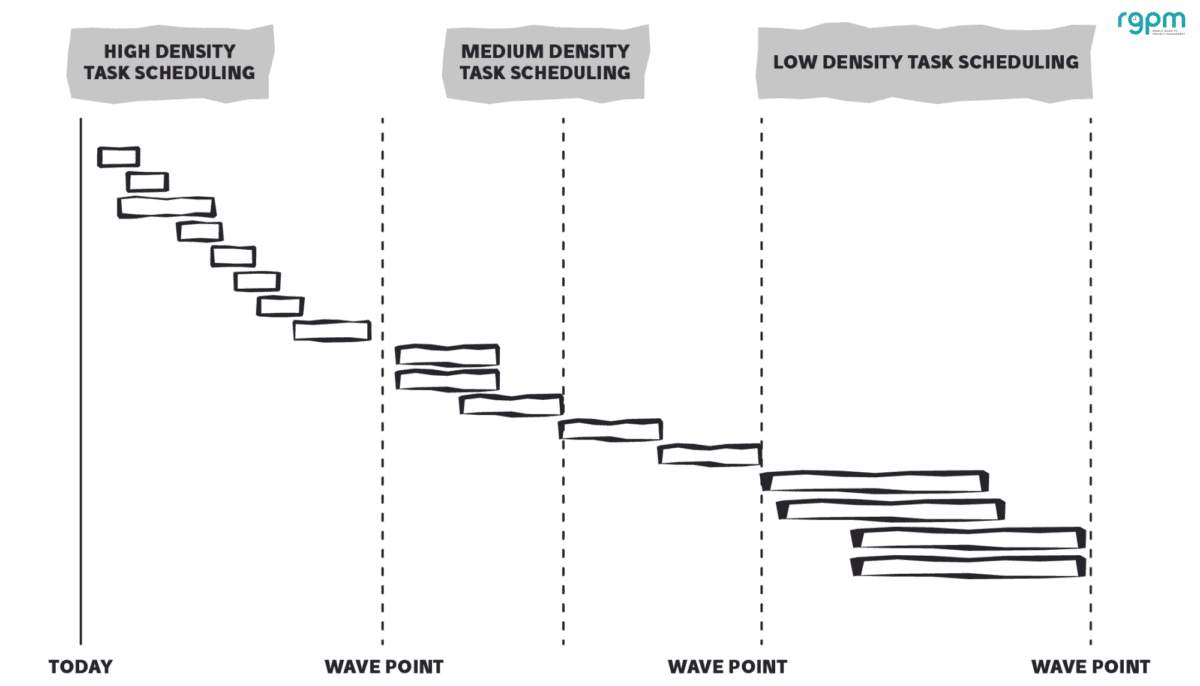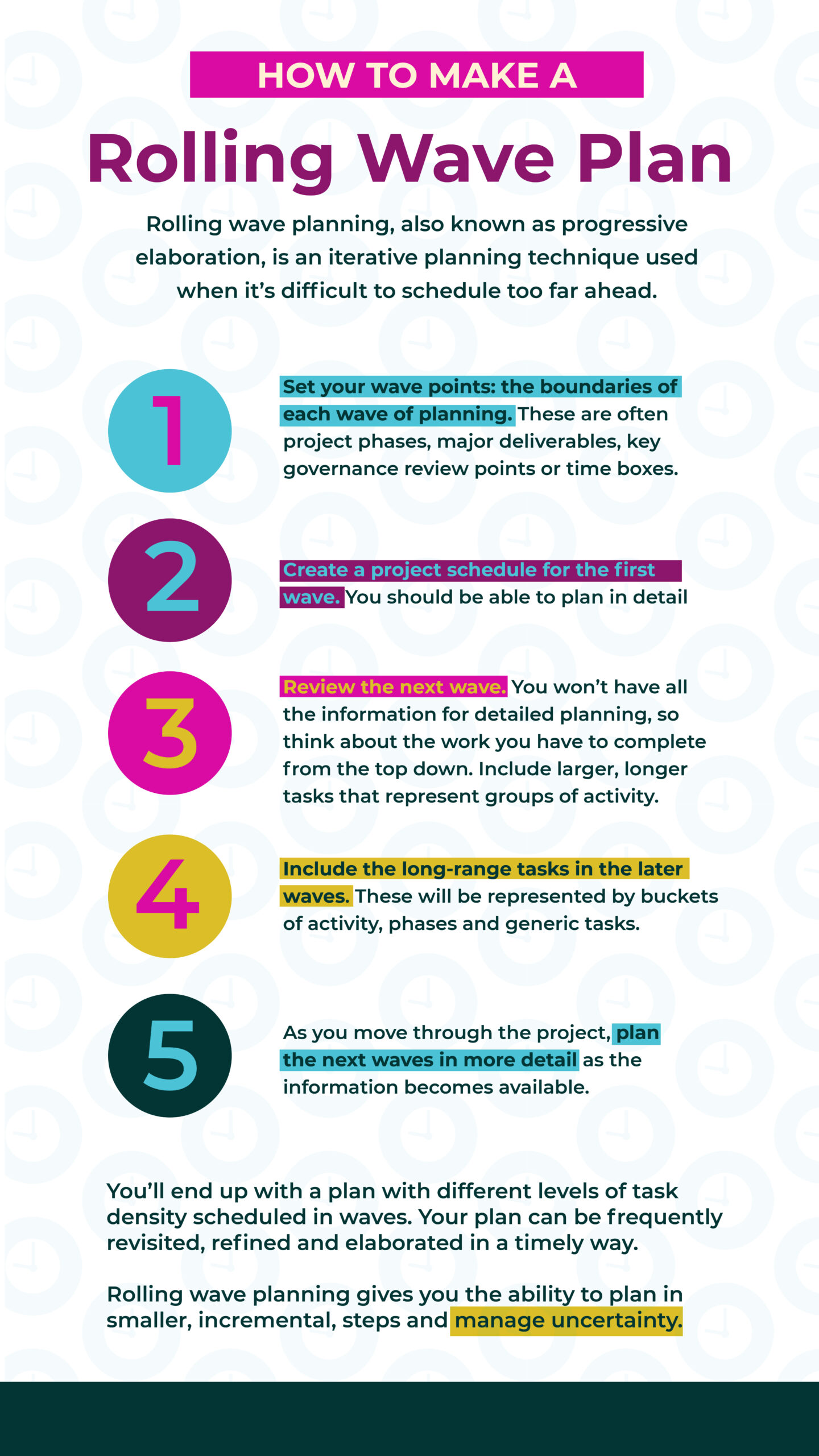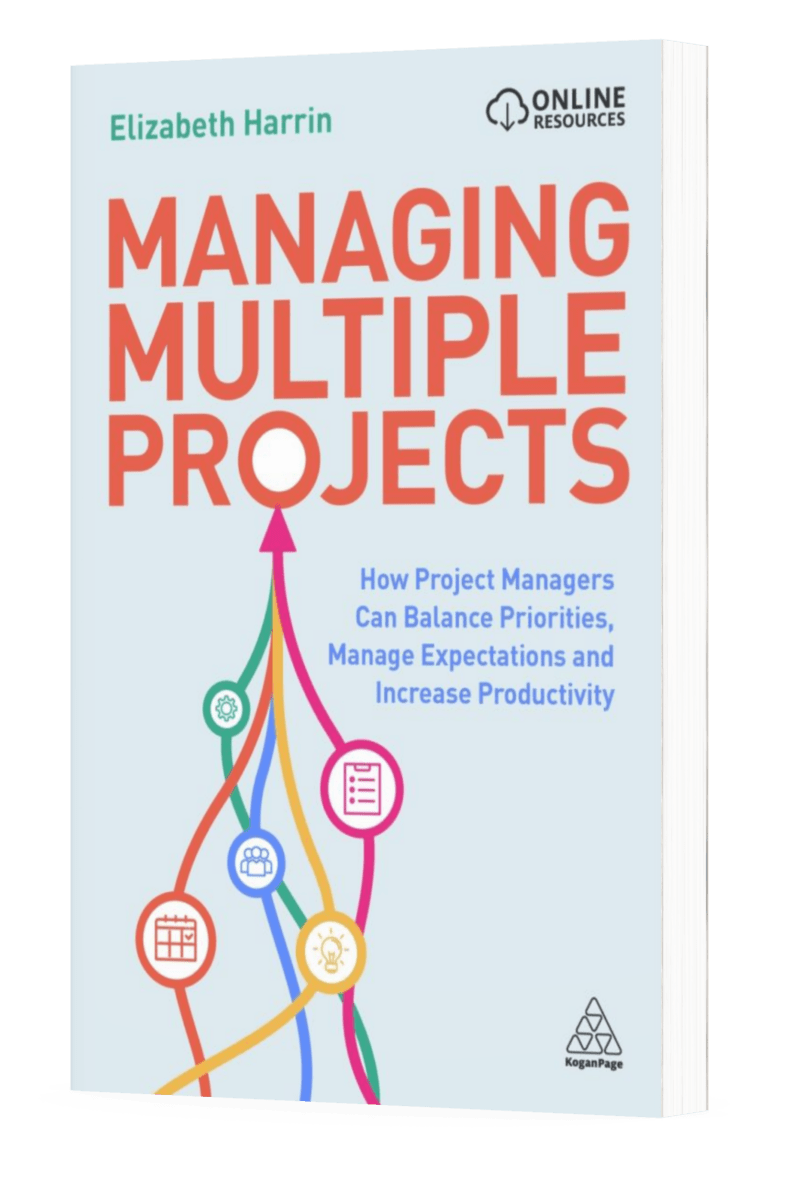How to do Rolling Wave Planning
This blog is reader-supported. When you purchase something through an affiliate link on this site, I may earn some coffee money. Thanks! Learn more.
Rolling wave planning, also known as progressive elaboration, is an iterative planning technique to use when it’s difficult (or pointless) to schedule too far ahead.
The APM Planning, Scheduling, Monitoring and Control Guide (2015) defines rolling wave planning as ‘the planning density that is achieved at different moments in time. Primarily more detailed planning in the immediate future and less detailed planning towards the end of the project.’
Rolling wave planning gives you the ability to plan in smaller, incremental, steps. Smaller steps are easier to track and manage, and they take less time to schedule because you are only creating a detailed plan for work that is on the short-term horizon.
The schedule is made up of waves: each wave has tasks planned at an appropriate level of detail, or density. Use high density, detailed planning for the tasks on the short-term horizon. This could represent the next month or 90 days or any other time period that makes sense for the overall duration of the project. This represents a full, in-depth schedule of the work that needs to happen during that period.
The next wave – the medium-term horizon – is made up of tasks planned at medium density: the tasks will have a longer duration and be less granular but they still represent the effort involved.
Finally, the long-term horizon is represented in one or more waves where tasks represent large clusters of work or phases. The tasks are not granular but act more as place markers for activities that are yet to be fully thought though and scheduled.

As the team undergoes the work, the project manager can constantly review the schedule and add more detail to the next waves as this is known. Consequently, you end up with a plan that is frequently revisited, refined and elaborated in a timely way. As planning techniques go, it’s pretty smart.
Benefits of rolling wave planning
The benefits of rolling wave planning are:
- Managing uncertainty
- Helping project stakeholders see the whole picture even if you don’t have the detail
- Reducing the amount of upfront planning.
Managing uncertainty
On many projects, you won’t know exactly what the work is going to look like later on. Some projects have evolving scope or high levels of complexity, where you don’t really know what’s going to be required as you move through the work. It’s helpful for managing uncertainty and dealing with the inevitable scope creep.
The exact project tasks required might depend on the outcome of the design phase, or may change once you’ve carried out customer focus groups, for example. Maybe you have agreed to rollout a new service to certain customers, and the intention is to deploy it to everyone if it’s a success.

Helping stakeholders see the whole picture
Your sponsor expects to see the timeline for the whole effort, but the exact deployment timetable is going to depend on the order you extend the service to customers, and you don’t know that yet.
If you cannot predict what’s coming with any degree of certainty, there’s not a lot of point in creating a detailed project schedule. You will only have to change it again later and you may have inadvertently set expectations with stakeholders that you then need to revisit.
Reducing the amount of upfront planning
Rolling wave planning reduces the amount of planning upfront. Managers like that because it means they feel the team can get started on delivery work and they start seeing progress more quickly.
Rolling wave planning is not the lazy way to get around the effort of scheduling. It’s a calculated move to show progress with creating a realistic and reasonable schedule, which makes it a good technique to use when you have multiple projects, because you are often under pressure to get going with delivery right now.
How to create a rolling wave plan
A rolling wave plan starts with knowing the major milestones or governance points. These become your wave points: the boundaries of each wave of planning. These could be anchored by project phases, major deliverables, key governance review points or simply that you have chosen to plan in three-month increments.
Use your high-level assumptions from the overall project plan to frame the work you are scheduling and what you already know about it.
The next step in the planning process is to create a project schedule for the first wave, in conjunction with the team. Look at the tasks (from your work breakdown structure if you have one) that need to be completed in that time frame and plan them out in detail. Then review the next wave. As you won’t have all the information for bottom up, detailed planning, think about the work you have to complete from the top down. Include larger, longer tasks that represent groups of activity.
If there is a task that runs into the next wave, for example, an activity which crosses the wave point, then plan that to the level of detail relevant to where the tasks starts. There is no point in cutting the task halfway through or changing the dates of your governance boundaries to fit. Plan flexibly: don’t stop scheduling tasks halfway through their duration just because they happen to cross a milestone.
Finally, include the long-range tasks. These are tasks towards the later parts and end of your project that can be scheduled at a low density. Include buckets of activity, phases and generic tasks that serve to represent what will be planned in detail once you get nearer.
The end result is a plan with different levels of task density scheduled in waves. Don’t forget that as time moves on you will need to revise those swathes of medium and low-density activity with more granular planning.
Hold consistent, regular planning sessions
As the project manager, it’s good practice to book out time to spend elaborating the next iteration of the plan as you get closer to the relevant time frame because people’s calendars get booked up.
As you will need input from the project team, you can book additional planning meetings or workshops now to use for creating the next iteration of the schedule. Gather accurate estimates for the work that is now on the near-term horizon, and update your schedule with those detailed activities now you know about them.
The planning work for a project using progressive elaboration never stops.
Engaging stakeholders in planning
As you create a rolling wave plan, engage stakeholders in what you are doing and explain what the plan represents. In particular, make sure they are aware that as you have not yet planned in detail, it is difficult (if not impossible) to guarantee an end date for the project.
Stakeholders need to be aware that as you schedule in greater detail, tasks may push any anticipated project closure date forward or backward. If the delivery date is fixed, that may mean they have to make decisions about what scope can be realistically achieved in the time.
Rolling wave planning with multiple projects
In a multi-project environment, priorities change quickly. Rolling wave planning for your project cuts out the effort of detailed planning where it’s difficult to do so. If priorities then change, you haven’t wasted any time creating a detailed schedule for a project that is no longer top priority.
In addition, the team can plan quite far ahead as well, because the schedule has less detail in the low-density waves, and that can help you review the impact of projects on each other. You can use the medium and low-density tasks to inform your overall consolidated schedule and to look for overlaps and dependencies between projects.
Use this approach to planning and schedule in waves where it makes sense to do so. It can work well for software development, even if you aren’t in a formal
However, a final warning: rolling wave planning can feel like a time-saving technique but it is not a real shortcut, because you do still have to do the planning; it is simply happening at a different point.
This is an edited extract from Managing Multiple Projects: How Project Managers Can Balance Priorities, Manage Expectations and Increase Productivity (Kogan Page, 2022.)
Get Your Copy
Managing Multiple Projects: How Project Managers Can Balance Priorities, Manage Expectations and Increase Productivity is a book that offers a comprehensive framework for juggling your workload and still leaving the office on time.

Pin for later reading:

